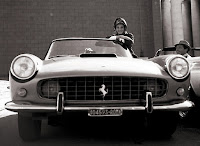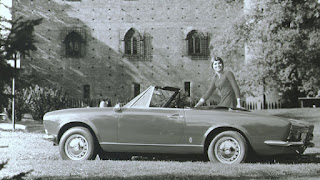Ferrari 250 (1953 to 1964):
The company's most successful early line, the 250 series included several variants. It was replaced by the 275 and the 330. Nearly all 250s share the the Colombo m.125 V12 2,953 cc (180 cu in) engine. It isn't big, but its light weight and impressive output (up to 280 PS (206 kW; 276 hp) made a big difference. The Ferrari V12 weighed hundreds of pounds less than its chief competitors; it was nearly half the weight of the Jaguar XK-E straight 6.
The first of the 250 line was the experimental 250 S "Berlinetta" entered in the 1952 Mille Miglia. Ferrari was outgunned in the long straights but fought back in the hills and curves and emerged victorious at the end.
The 1963 330 "America" -a 250 in all but name- shared the same chassis but it had a 4.0 L. engine. 50,330 Americas were built. California socialite Sandra Ilene West was buried at the wheel of her car following a 1977 drug overdose: her instructions specified that she be clad in her lace nightgown with the driver’s seat "slanted at a comfortable angle". The car (and driver) are interred at the Alamo Masonic Cemetery, San Antonio, Texas.
 Mercedes 300SL (1954-1963):
Mercedes 300SL (1954-1963):Introduced in 1954 as a two-seater hardtop, it was later offered as an open roadster.
Built by Daimler-Benz AG the road model was suggested by Max Hoffman: intended for the booming post-war American market it was introduced at the 1954 New York Auto Show, unlike previous models introduced in either Frankfurt or Geneva.
The 300SL was best known for both its distinctive gull wing doors and the first-ever four-stroke gasoline direct injection. The gull wing version was available from March 1955 to 1957. Production of the roadster ended in 1963 with the introduction of the 230SL.
 Austin- Healey 3000 (1959-1967):
Austin- Healey 3000 (1959-1967):The best known of the "big" Healey models, the bodywork was made by Jensen Motors and the cars were assembled at the BMC Abingdon works. The original Austin Healey 3000 has a 2912 cc I6 engine, with twin SU carburetors and Girling front disc brakes. It was referred to as the "Mark I" after the "Mark II" was released. The original 3000 was built from March 1959 to March 1961 with the model designations BT7 (4-seat version) and BN7 (2-seater). A BT7 3000 hardtop with overdrive was tested by The Motor magazine in 1960 and had a top speed of 115 mph (185 km/h), going from 0–60 mph (97 km/h) in 11.7 seconds.
The 3000 Mk II was introduced in 1961 and came with three SU HS4 carburetors and an improved camshaft, giving it a top speed of 112.9 mph (181.7 km/h) and 0–60 mph (97 km/h) in 10.9 seconds.
The 3000 Mk III was launched in October 1963, and remained in production until the end of 1967 when production of Austin-Healeys ceased. Classified as the BJ8, the new model was the most powerful and luxurious of the big Healeys, with a walnut-veneer dash, wind-up windows, and a 150 hp engine. Improvements to the engine included a new camshaft and valve springs and twin SU 2" HD8 carburetors, together with a new design of exhaust system.
Austin Healey 3000's have a long competition history and raced at most major racing circuits around the world, including Sebring (USA), Le Mans (France), and Mount Panorama Circuit, Bathurst (Australia).
The BMC competitions department successfully rallied the 3000 from its introduction, but development of the cars effectively ended in 1965, mainly due to the success of the Mini Cooper 'S'.
 Jaguar (XK-) E Series, (1961-1975):
Jaguar (XK-) E Series, (1961-1975):The Jaguar E-Type (UK) or XK-E (US) combined good looks, high performance and competitive pricing -established the marque as an icon of 1960 sports cars: more than 70,000 E-Types were sold during its lifespan. Initially designed as a two-seater grand tourer in both coupé and convertible, on its release Enzo Ferrari called it "The most beautiful car ever made."
The model was produced in three distinct versions which are now generally referred to as "Series 1", "Series 2" and "Series 3"; another transitional series is known unofficially as "Series 1½" and several limited-edition variants came out.
S1 used the triple SU carburetted 3.8 litre 6-cylinder Jaguar XK6 engine from the XK150S. better cooling aided by an enlarged "mouth" and twin electric fans, and uprated brakes are hallmarks of Series 2 cars were de-tuned in US with twin strombergs and larger valve clearances, but they still had triple SUs in the UK and the much tighter valve clearances. The S2 engine is easily identified by the change from polished cam covers to a more industrial "ribbed" appearance.
In S3 a new 5.3 L. V12 engine was introduced, with updated brakes and standard power steering.
 MGB Midget (1961 - 1979):
MGB Midget (1961 - 1979):The MG Car Company was founded in the 1920s by Cecil Kimber. Produced by MG division of the British Motor Corporation from 1961 to 1979, it revived a name used on earlier models. The Midget wasn't a particularly powerful machine, and it was hugely popular.
No, it doesn't fit in the same class as the Ferraris and Lambos; but, well... WTF. This is my blog and I loved it anyway ;)
The first model was essentially a version of the Austin-Healey Sprite MKII with a 948 cc A-Series and twin SU carburetors. A hard top, heater, radio and luggage rack were available as factory fitted extras.
In 1962 the engine was increased to 1098 cc.:16,080 of the small-engined version and 9601 of the 1098 were made.
A car with the 948 cc engine was tested by "The Motor" in 1962 and had a top speed of 87.9 mph (141.5 km/h) and could accelerate from 0-60 mph (97 km/h) in 18.3 seconds. The test car cost £689 including taxes on the UK market.
In 1964 the engine block was strengthened and larger main bearings were fitted, increasing the power to 59 hp. In '66 the engine grew to 1275 cc using the development seen on the Mini-Cooper 'S'. In 1971 the compression ratio on North American engines was reduced to 8.0:1. Engine power output fell to 54.5 bhp @ 5500 RPM and 67 lb-ft of torque @ 3250 RPM.
Originally devised by Standard-Triumph to compete in the small sports car market which had opened up with the introduction of the Austin-Healey Sprite, the Spitfire was introduced at the London Motor Show in 1962 and was based on a design by Giovanni Michelotti. The platform for the car was largely based upon the chassis, engine, and running gear of the Triumph Herald saloon, and was manufactured at the Standard-Triumph works at Canley, Coventry.
The original Spitfire 4 (aka Mark I) featured an in-line four producing 63 bhp (47 kW) at 5750 rpm, and 67 ft·lb (91 N·m)of torque at 3500 rpm. This gave a top speed of 92 mph (148 km/h), and it would do to 60 mph (97 km/h) in 17.3 seconds. A number of revisions were implemented over the '60s and '70s, culminating in the 1500 Spitfire which produced 71 bhp (53 kW) at 5500 rpm, and produced 82 ft·lb (111 N·m) of torque at 3000 rpm.Top speed was now at the 100 mph (160 km/h) mark, and 0 to 60 mph (97 km/h) was reached in 13.2 seconds.
Lamborghini Miura (1966-1972):
Produced from 1966 to 1972, the car is widely considered to have begun the trend of high performance, two-seater, mid-engined sports cars. At launch it was the fastest production road car available. The Miura was originally conceived by Lamborghini's engineering team against the wishes of Ferruccio Lamborghini, who wanted grand touring designs rather than the racecar-derived machines produced by rival Ferrari. When the prototype P400 debuted at the 1966 Geneva show, the car received a stellar reception for its styling and revolutionary design.
As Lamborghini's halo car, the Miura received periodic updates and remained in production until 1972. It was replaced by the Countach in 1974.
The 124 Sport Spider debuted at the November 1966 Turin Auto Show. Designed and manufactured by Italian carozzeria Pininfarina, Fiat continued to market the car as the 2000 Spider from 1979 to 1982: from 1983 to the end of its production in 1985 it was marketed as as the Pininfarina Spider Azzura.
The car was sold in Europe and the U.S. from its introduction until 1975 when it was modified to comply with new U.S. regulations, and no European version was produced. Sales in Europe resumed in 1983 under the name Pininfarina Europa Spider.
The engine was a double overhead cam, aluminum crossflow head version of the sedan's pushrod unit.
The 124 started in 1966 with a capacity of 1438 cc progressively increasing to 1608 cc in 1970 (although this reduced to 1592 cc in 1973), 1756 cc in 1974 and finally 1995 cc in 1979. Designed by Dan Vano. Bosch fuel injection replaced the previously used Weber carburetors midway through 1980. In 1981 and 1982, Fiat partnered with Legend Industries to create approximately 700 turbo models. There was also a supercharged model called Volumex offered toward the end of production, and sold only in Europe. This family of engines was designed by ex-Ferrari chief engineer Aurelio Lampredi and in one form or another remained in production into the 1990s giving it one of the longest production runs in history.
The original 1438 cc engine produced 96bhp @ 6000rpm, doing 0-60mph in 11.9s and had a max speed of 106mph. The final 1995 cc fuel injection turbo put out 120bhp @ 6000rpm, and did 0-60mph in 10.1s with the same top speed.

































































No comments:
Post a Comment